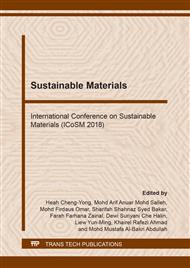[1]
R. Bátorfi, B. Illés, and O. Krammer, Whisker formation from SnAgCu alloys and tin platings - review on the latest results,, in 2015 IEEE 21st International Symposium for Design and Technology in Electronic Packaging (SIITME), 2015, p.373–376.
DOI: 10.1109/siitme.2015.7342356
Google Scholar
[2]
Y. Liu, P. Zhang, Y. M. Zhang, J. Ding, J. J. Shi, and Z. M. Sun, Spontaneous growth of Sn whiskers and a new formation mechanism,, Mater. Lett., vol. 178, p.111–114, (2016).
DOI: 10.1016/j.matlet.2016.04.173
Google Scholar
[3]
H. H. Manko, Solders and soldering: materials, design, production, and analysis for reliable bonding. McGraw-Hill, (2001).
Google Scholar
[4]
M. A. A. Mohd Salleh, S. McDonald, and K. Nogita, Non-Metal Reinforced Lead-Free Composite Solder Fabrication Methods and its Reinforcing Effects to the Suppression of Intermetallic Formation: Short Review,, Appl. Mech. Mater., vol. 421, p.260–266, (2013).
DOI: 10.4028/www.scientific.net/amm.421.260
Google Scholar
[5]
M. A. A. Mohd Salleh, M. H. Hazizi, Z. A. Ahmad, K. Hussin, and K. R. Ahmad, Wettability, Electrical and Mechanical Properties of 99.3Sn-0.7Cu/Si3N4 Novel Lead-Free Nanocomposite Solder,, Adv. Mater. Res., vol. 277, p.106–111, (2011).
DOI: 10.4028/www.scientific.net/amr.277.106
Google Scholar
[6]
M. A. A. Mohd Salleh, C. M. Gourlay, J. W. Xian, S. A. Belyakov, H. Y.asuda, S. D. McDonald, and K. Nogita,In situ imaging of microstructure formation in electronic interconnections,, Sci. Rep., vol. 7, p.40010, Jan. (2017).
DOI: 10.1038/srep40010
Google Scholar
[7]
G. Zeng, S. D. McDonald, D.Mu, Y.Terada, H. Yasuda, Q. Gu, M. A. A. Mohd Salleh, and K. Nogita,., The influence of ageing on the stabilisation of interfacial (Cu,Ni)6(Sn,Zn)5 and (Cu,Au,Ni)6Sn5 intermetallics in Pb-free Ball Grid Array (BGA) solder joints,, J. Alloys Compd., vol. 685, p.471–482, (2016).
DOI: 10.1016/j.jallcom.2016.05.263
Google Scholar
[8]
N. M. Nasir, N. Saud, M. Nazree Derman, A. A. M. Salleh, M. I. I. Ramli, and R. M. Said, Effect of TiO2 Reinforcement on Microstructure and Microhardness of Low-Silver SAC107 Lead-Free Solder Composite Solder,, Mater. Sci. Forum, vol. 803, no. February 2016, p.273–277, (2014).
DOI: 10.4028/www.scientific.net/msf.803.273
Google Scholar
[9]
L. C. Tsao, Suppressing effect of 0.5 wt.% nano-TiO2addition into Sn-3.5Ag-0.5Cu solder alloy on the intermetallic growth with Cu substrate during isothermal aging,, J. Alloys Compd., vol. 509, no. 33, p.8441–8448, (2011).
DOI: 10.1016/j.jallcom.2011.05.116
Google Scholar
[10]
M. I. I. Ramli, N. Saud, M. A. A. M. Salleh, M. N. Derman, and R. M. Said, Effect of TiO2 additions on Sn-0.7Cu-0.05Ni lead-free composite solder,, Microelectron. Reliab., vol. 65, p.255–264, (2016).
DOI: 10.1016/j.microrel.2016.08.011
Google Scholar
[11]
M. J. Bozack, S. K. Snipes, and G. N. Flowers, Methods for fast, reliable growth of Sn whiskers,, Surf. Sci., vol. 652, p.355–366, (2015).
DOI: 10.1016/j.susc.2016.01.010
Google Scholar
[12]
M. Sun, X. Long, M. Dong, Y. Xia, F. Hu, A. Hu, and M. Li, Mitigation of tin whisker growth by inserting Ni nanocones,, Mater. Charact., vol. 134, p.354–361, (2017).
DOI: 10.1016/j.matchar.2017.11.002
Google Scholar
[13]
R. T. Winslow, G. Iyer, and M. M. Cruz, Hot Solder Dip and Minimizing Thermal Gradients. (2006).
Google Scholar
[14]
C. K. Lin and T. H. Lin, Effects of continuously applied stress on tin whisker growth,, Microelectron. Reliab., vol. 48, no. 10, p.1737–1740, (2008).
DOI: 10.1016/j.microrel.2008.04.013
Google Scholar
[15]
E. Chason, N. Jadhav, F. Pei, E. Buchovecky, and A. Bower, Growth of whiskers from Sn surfaces: Driving forces and growth mechanisms,, Prog. Surf. Sci., vol. 88, no. 2, p.103–131, (2013).
DOI: 10.1016/j.progsurf.2013.02.002
Google Scholar
[16]
M. W. Boettinger, William J., Kil-Won Moon, Gery Stafford, and Mark Vaudin, Lead-Free Surface Finishes for Electronic Components: Tin Whisker Growth.
Google Scholar
[17]
B.-Z. Lee and D. N. Lee, Spontaneous growth mechanism of tin whiskers,, Acta Mater., vol. 46, no. 10, p.3701–3714, (1998).
DOI: 10.1016/s1359-6454(98)00045-7
Google Scholar
[18]
B. Illés and B. Horváth, Tin whisker growth from micro-alloyed SAC solders in corrosive climate,, J. Alloys Compd., vol. 616, p.116–121, (2014).
DOI: 10.1016/j.jallcom.2014.07.103
Google Scholar
[19]
A. Skwarek, M. Pluska, J. Ratajczak, A. Czerwinski, K. Witek, and D. Szwagierczak, Analysis of tin whisker growth on lead-free alloys with Ni presence under thermal shock stress,, Mater. Sci. Eng. B, vol. 176, no. 4, p.352–357, (2011).
DOI: 10.1016/j.mseb.2010.10.001
Google Scholar
[20]
D. Susan, W. Yelton, J. Michael, and P. Vianco, Recent Tin Whisker Research At Sandia. (2012).
Google Scholar
[21]
W. J. Boettinger, C. E. Johnson, L. A. Bendersky, K.-W. Moon, M. E. Williams, and G. R. Stafford, Whisker and Hillock formation on Sn, Sn–Cu and Sn–Pb electrodeposits,, Acta Mater., vol. 53, no. 19, p.5033–5050, (2005).
DOI: 10.1016/j.actamat.2005.07.016
Google Scholar


